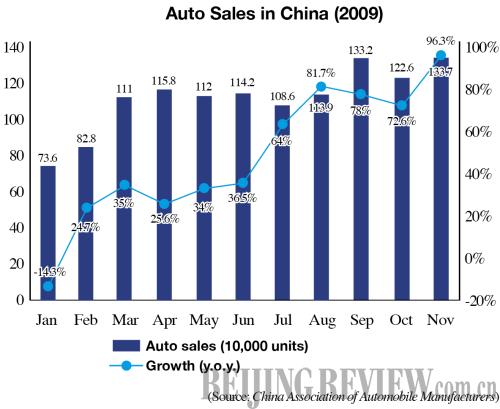| 
Numbers of the Week
5.7%
Housing prices in 70 large and medium-sized cities grew 5.7 percent year on year, 1.8 percentage points higher than in October, according to the National Bureau of Statistics.
70 billion yuan
Sales from the welfare lottery in China exceeded 70 billion yuan ($10.2 billion) this year, according to the China Welfare Lottery Distribution and Management Center.
TO THE POINT: According to November economic figures, the Chinese economy is on track for recovery on all fronts. The logistics industry recoups its strength, though woes on the trade front require more time to fully recover. By partly withdrawing tax incentives for prospective real estate and auto buyers, China aims to calm the bubbling markets. Auto behemoth General Motors forges a joint venture with Shanghai Automotive Industry Corp. Group to maneuver into the emerging Indian auto market. Canadian handset maker RIM launches a version of the BlackBerry that supports the TD network of China Mobile for millions of individual users in China. Siemens makes a push into green business in China with a 2-billion-yuan ($293 million) sale.
By HU YUE
Major Economic Figures For November
CPI and PPI
The consumer price index (CPI), a barometer of inflation, grew 0.6 percent in November year on year, turning around from the 0.5-percent decrease in October, said the National Bureau of Statistics at a press conference held on December 11.
The producer price index (PPI), a gauge of inflation on the wholesale level, fell 2.1 percent from the same period of last year, 3.7 percentage points lower than in October.
Industrial output
Industrial output nationwide grew 19.2 percent in November year on year, following a 16.1-percent increase in October.
Retail sales
Retail sales totaled 1.1339 trillion yuan ($165.9 billion) in November, increasing 15.8 percent from one year earlier, compared to a 16.2-percent growth rate seen in October.
Bank loans
Newly added bank loans denominated in renminbi totaled 294.8 billion yuan ($43.1 billion) in November, slightly higher than the 253 billion yuan ($37 billion) recorded in October.
Money supply
China's broad money supply (M2) stood at 59.46 trillion yuan ($8.7 trillion) at the end of November, growing 29.74 percent year on year.
Urban investment in fixed-assets
China's urban investment in fixed-assets rose 32.1 percent in the first 11 months of 2009, 5.3 percentage points higher than that of the same period of last year.
Slowly Improving Logistics
As a wave of optimism returns to the Chinese economy, the country's once-reeling logistics industry—combining transport, storage, freight agencies and express delivery—has started to show signs of improvement, though it will still take time to fully shake off fallout from the economic downturn.
According to data from the China Federation of Logistics and Purchasing (CFLP), the total value of social logistics goods from January to September reached 69.41 trillion yuan ($10.16 trillion), an increase of 3.3 percent year on year. Although modest, the increase represents a sharp reversal of the downward trend experienced in the first half of this year.
From warehouse management to home delivery, the logistics industry, dubbed the "enabler of commerce," provides efficient connections between each link of the industrial supply chain. But one defect stands out—its extreme sensitivity to swings in domestic and overseas demands. As China's foreign trade has yet to recover, many logistics companies are still struggling to make ends meet.
He Hui, chief economist with the China Logistics Information Center, said that a number of companies are spilling red ink as freight traffic continues to drop.
Logistics costs in China have also been on the rise this year, putting a squeeze on the sector's profit margins, said He.
The prices of gasoline and diesel, which account for almost 30 percent of logistics costs, were raised substantially this year by the National Development and Reform Commission, the top economic planner.
In response, He suggested that companies improve their warehousing and distribution technologies to strengthen their transport efficiency.
Housing Stability First
While vowing to maintain the heavy economic stimulus, the Chinese Government has begun to wield policy leverages to pour cold water on overheating markets.
People who sell homes less than five years after making the purchase must pay a 5.55-percent business tax starting next year, the State Council said.
The reinstatement of the business tax is the government's latest attempt to combat rampant speculation blamed for soaring property prices nationwide since mid-2009.
On December 29, 2008, policymakers decided individuals would be exempt from the 5.55-percent business tax if they sold their homes after two years instead of five.
Chen Guoqiang, Director of the Real Estate Research Institute at Peking University, said re-instating the tax was a moderate leverage to cool the market euphoria without pricking the housing bubble.
Most importantly, the tax shows policymakers will not leave the market to find equilibrium on its own, he said.
In another move, the government announced an increase in the favorable tax rate for small-capacity auto purchases from 5 percent to 7.5 percent for next year.
The previous tax cut from 10 percent to 5 percent added fuel to the buoyant domestic auto market that was experiencing skyrocketing sales.
Pooling Auto Assets
General Motors Corp. recently teamed up with Shanghai Automotive Industry Corp. Group (SAIC) to establish a $100-million 50-50 joint venture in Hong Kong to explore the emerging Asian auto markets.
The 50-50 venture, in which SAIC will invest cash and GM will utilize existing Indian assets, will produce small cars and mini-commercial vehicles currently produced at GM and SAIC's China ventures based in India.
| 